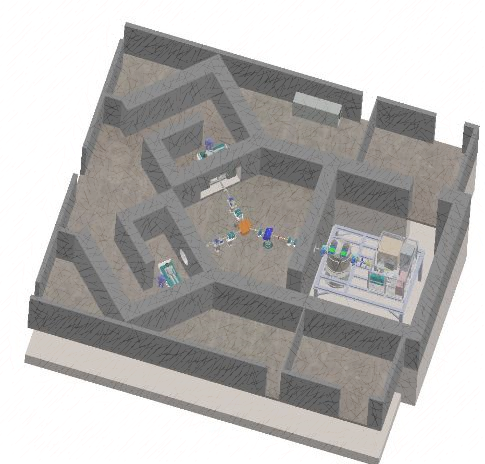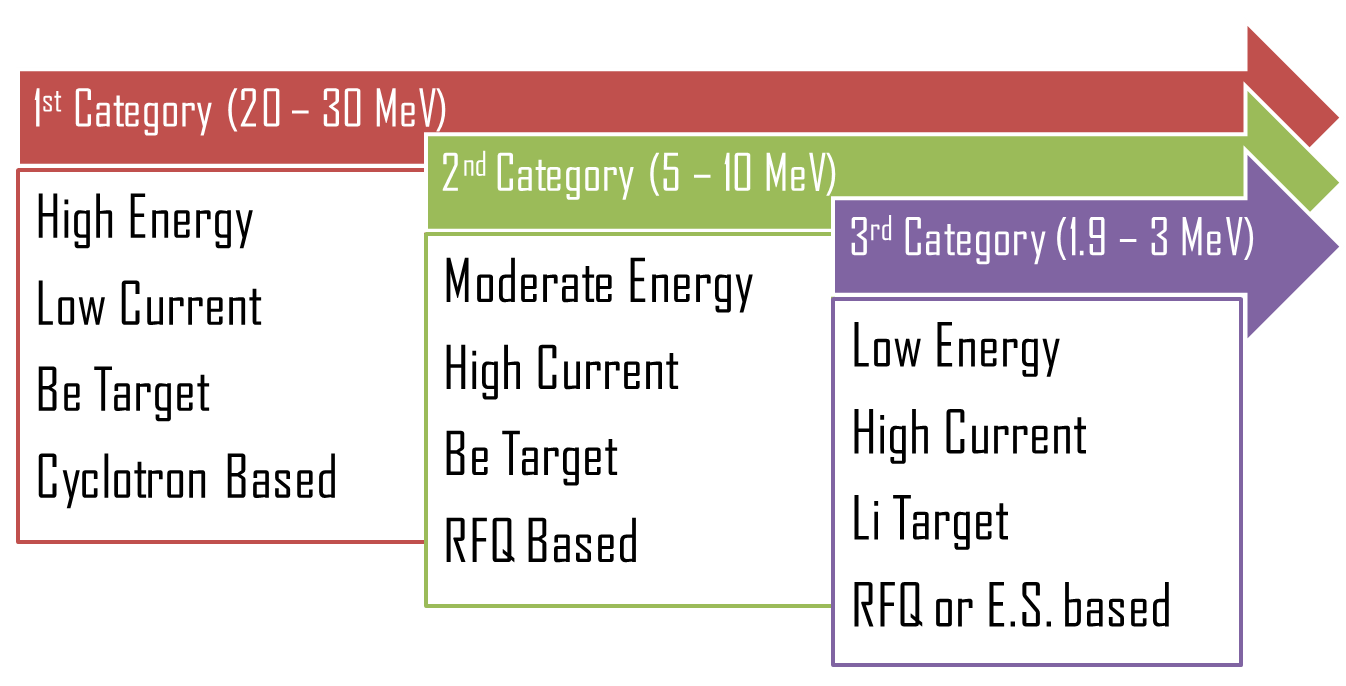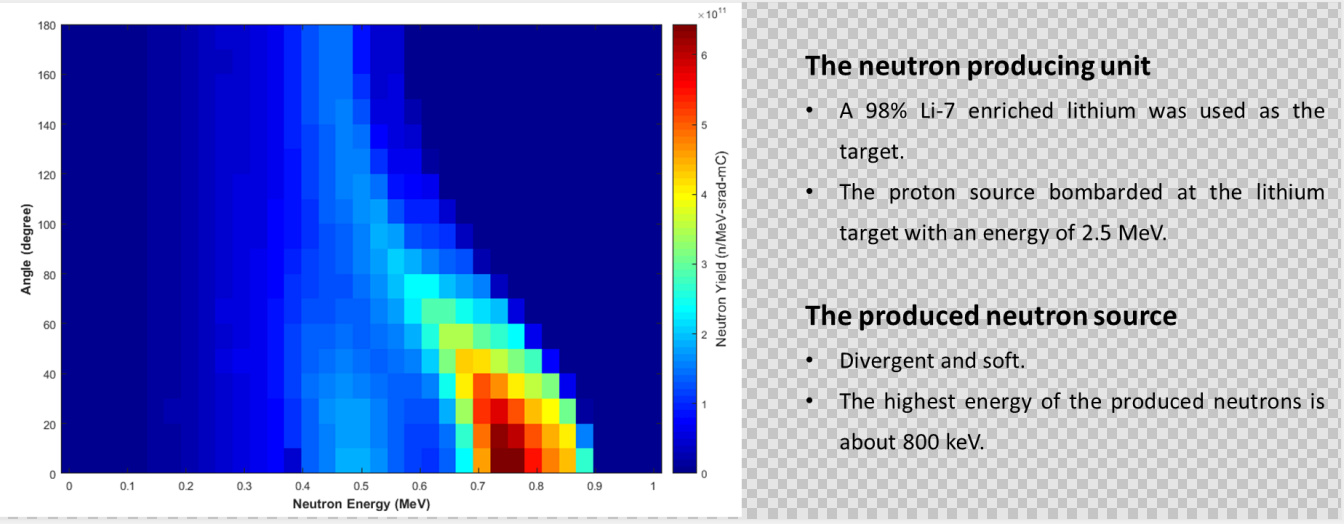厦门弘爱医院加速器中子源(Xiamen Accelerator-based Neutron source, XAN)正处于建造阶段,预期于2020年达到全功率运行并输出超热中子束通率达到1.0 x 109 (epi. n s-1 cm-2)以上。该中子源由一部静电式串列加速器驱动,相比于一般电磁式加速器具有容易建造、维修简单、鲁棒性强、能功耗低、质子能量可调变等优点,缺点为加速器本体较大,加速距离较长,不适合应用于高能加速。XAN的设计用途为进行硼中子俘获治疗(boron neutron capture therapy, BNCT)相关研究与临床治疗。XAN中子源系通过2.5MeV质子束以10 mA的强束流轰击锂-7金属靶产生,经高致密(> 3.2 g cm-3)、高纯度的MgF2缓速体减速与过滤后形成所需的超热中子束。整个设施配置了两条水平束与一条垂直束(两条水平束可见于Figure 1,垂直束位于HEBL下方)。
XAN自2014年起开始设计,于2018年开始投入建造,为第三代的加速器BNCT设备(Figure 2),与XAN采用同样设计的主要BNCT设施还有芬兰赫尔辛基大学附属中央医院(HUCH)、名古屋大学加速器中子源(NUANS),以及日本国家癌症中心等三座加速器BNCT设施(见Table 1)。XAN是当前所有加速器BNCT设施中,唯二按照医疗器械ISO13485质量要求建造的设施(另一个为住友重工的HM-30系统,属于第一代系统)。第三代加速器BNCT设施的共通点在于使用低能量质子束搭配锂金属靶(7Li),其所产生的中子能谱较其他两代设计明显集中于低能区域(Figure 3),具有以下两个显著优点:
1. 不易发生门阈核反应,降低活化污染;
2. 更容易进行慢化,提高产出中子的使用效率;
3. 无高能快中子拖尾,有效降低快中子污染剂量。
对于常见于锂靶中子源的问题,亦即锂金属的低熔点(约180℃)与放射性副产物(7Be,半衰期53.12天),在现代工程技术下均可以获得合理的控制,并持续获得技术改善。尤其在考虑了结构物、屏蔽体、射束整形体(beam shaping assembly, BSA)及整个靶体范围的放射性下,锂靶的使用有其防护及绿色优点。XAN采取了控制靶站使用时数、半自动换靶工程技术与采用移动屏蔽等手段有效降低人员的受曝剂量。
与其他第三代设施相比,XAN的设计采用了新式的BSA设计,包括了将靶站与缓速体之间的位置进行了优化配置,同时对缓速体及反射体几何和材质做了重新设计,并对BSA进行了轻量化改进。以上的改进设计使XAN的质子运行束流降低至10 mA但仍可输出高质量、高强度的超热中子束,并在30分钟内完成BNCT治疗;XAN质子束流仅为HUCH设施的三分之一,全球同比最低束流需求的设计。
最后,XAN的设计有效治疗深度(Advantage Depth, AD),在采用Modified Snyder Phantom, T/N = 3.0的条件下,XAN的治疗深度可达11公分,强穿模式下则还可以提供更深的治疗深度。2020年春天XAN完成假体内验证与调整后,BNCT的有效治疗深度可望正式突破10公分。
Table 1 The representative 3rd Category AB-BNCT Facilities
Facility |
Country |
Accelerator |
Target Design |
Nominal Proton Energy |
Designed Beam Current |
Status |
National Cancer Center |
Japan |
Electromagnetic,
RFQ |
Solid Lithium Target |
2.5 MeV |
20 mA |
Built in 2016,
Commissioning |
Nagoya University |
Japan |
Electrostatic,
Dynamitron |
Sealed Lithium Target |
2.8 MeV |
15 mA |
Built in 2015,
Commissioning |
Helsinki University Central Hospital |
Finland |
Electrostatic,
Tandem |
Rotating Solid Lithium Target |
2.5 MeV |
30 mA |
Built in 2018, Preclinical Study |
Xiamen Humanity Hospital |
China |
Electrostatic,
Tandem |
Solid Lithium Target |
2.5 MeV |
10 mA |
Under Construction |
The accelerator neutron source at the Xiamen Humanity Hospital BNCT Center is now under construction; it aims to reach its full operation in 2020 and deliver an epithermal neutron flux of higher than 1.0 x 109 epi. n s-1 cm-2. The neutron source is designed for boron neutron capture therapy (BNCT) driven by a Tandem accelerator (electrostatic type). A nominal 10mA proton beam runs at a nominal operation energy of 2.5 MeV, and it hits a Li-7 target generating relatively soft but intensive neutrons. The generated neutrons are further moderated and filtered by a high density (>3.2 g cm-3) MgF2 moderator. The accelerator-based BNCT system contains two horizontal beams and one vertical beam.

Figure 1 The floor plan of the Xiamen AB-BNCT facility (B1)

Figure 2 The 3 common known models of accelerator-based neutron sources for BNCT

Figure 3 The double differential neutron spectrum of a thin Li-7 target bombed by 2.5-MeV protons
刘渊豪 教授
南京中硼联康医疗科技有限公司
E-mail:liuyuanhao@neuboron.com

